- ¿Qué es un parque nacional?
-
- Mar de las Calmas (propuesta)
- Aigüestortes i Estany de Sant Maurici
- Cabrera Archipelago
- Cabañeros
- Caldera de Taburiente
- Doñana
- Garajonay
- Atlantic Islands of Galicia
- Monfragüe
- Ordesa y Monte Perdido
- Picos de Europa
- Sierra de Guadarrama
- Sierra de las Nieves
- Sierra Nevada
- Tablas de Daimiel
- Teide
- Timanfaya
- La Red de un vistazo
- ¿Cómo funciona La Red?
- Cartography
- Central Booking
Transectos: Dique Roto Sur
Transectos: Dique Roto Sur
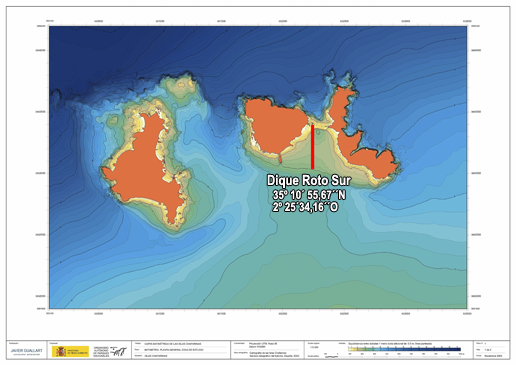 Resumen de las observaciones realizadas en cada metro de profundidad en el Dique Roto Sur (Chafarinas). Autor: Luis Sánchez Tocino. Universidad de Granada
Resumen de las observaciones realizadas en cada metro de profundidad en el Dique Roto Sur (Chafarinas). Autor: Luis Sánchez Tocino. Universidad de Granada
 Representación del relieve del terreno en el Dique Roto Sur
Representación del relieve del terreno en el Dique Roto Sur
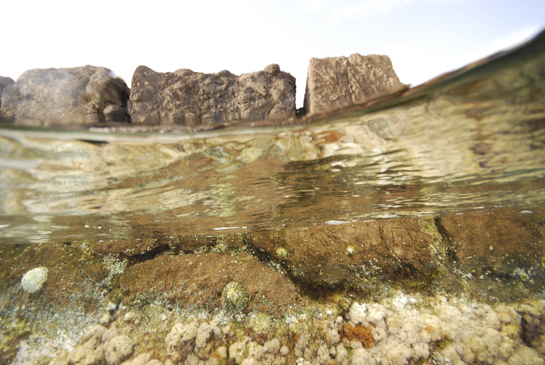 0m. Las lapas Patella ferruginea y Cymbulia nigra son los animales más abundantes, a simple vista, en el piso mediolitoral superior de este transecto.
0m. Las lapas Patella ferruginea y Cymbulia nigra son los animales más abundantes, a simple vista, en el piso mediolitoral superior de este transecto.
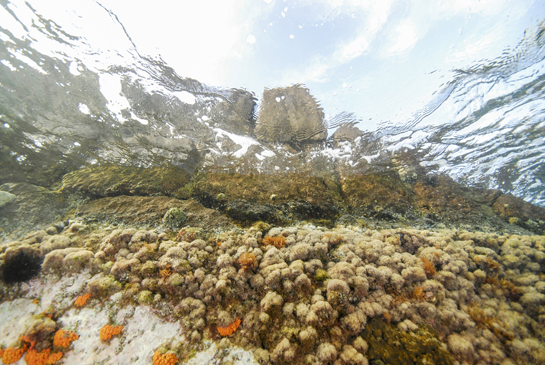 0m. Las lapas Patella ferruginea y Cymbulia nigra son los animales más abundantes, a simple vista, en el piso mediolitoral superior de este transecto.
0m. Las lapas Patella ferruginea y Cymbulia nigra son los animales más abundantes, a simple vista, en el piso mediolitoral superior de este transecto.
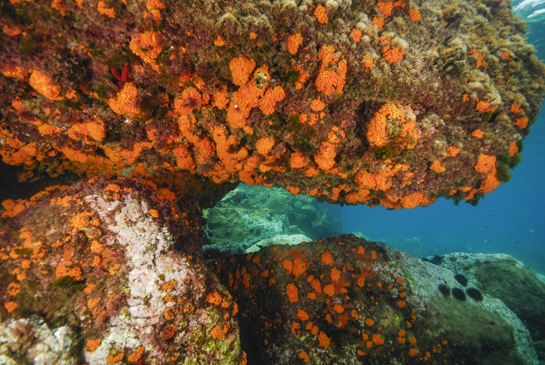 -1m. La disminución de la luz en los recovecos que se forman debajo de los restos emergidos del “Dique Roto”, permiten el desarrollo de una Comunidad de Algas Esciáfilas de Modo Calmo, en donde destaca, por su llamativo color naranja, el coral Astroides calycularis.
-1m. La disminución de la luz en los recovecos que se forman debajo de los restos emergidos del “Dique Roto”, permiten el desarrollo de una Comunidad de Algas Esciáfilas de Modo Calmo, en donde destaca, por su llamativo color naranja, el coral Astroides calycularis.
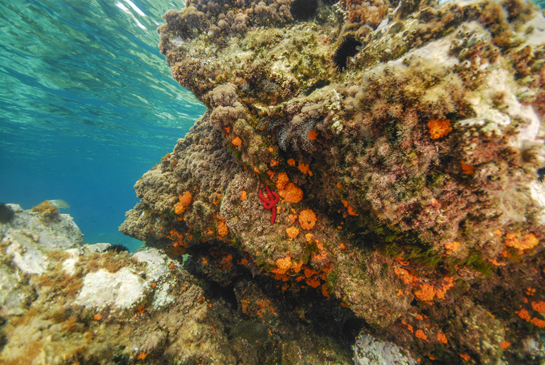 -1m. En la parte central podemos ver una estrella púrpura Ophidiaster ophidianus
-1m. En la parte central podemos ver una estrella púrpura Ophidiaster ophidianus
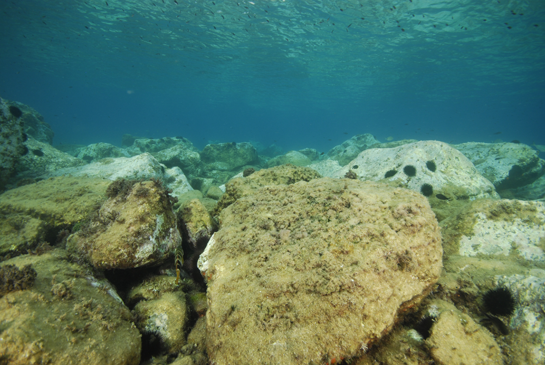 -1m. El ramoneo de los erizos, principalmente el erizo negro (Arbacia lixula) y el erizo común (Paracentrotus lividus), limita el crecimiento de las algas al de especies coralinas incrustantes, dando lugar a la denominada Comunidad de Algas Calcáreas y Erizos.
-1m. El ramoneo de los erizos, principalmente el erizo negro (Arbacia lixula) y el erizo común (Paracentrotus lividus), limita el crecimiento de las algas al de especies coralinas incrustantes, dando lugar a la denominada Comunidad de Algas Calcáreas y Erizos.
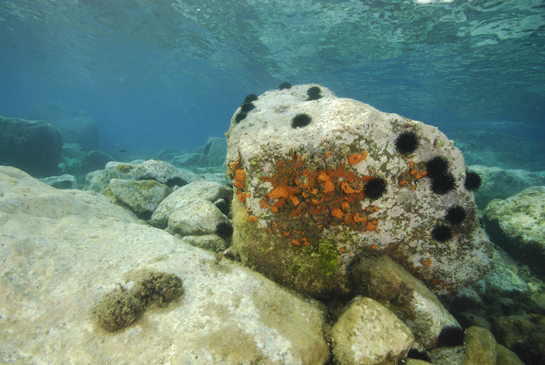 -1m. Los pequeños extraplomos que se dan en esta zona de poca profundidad son aprovechados por diferentes invertebrados esciáfilos para desarrollarse.
-1m. Los pequeños extraplomos que se dan en esta zona de poca profundidad son aprovechados por diferentes invertebrados esciáfilos para desarrollarse.
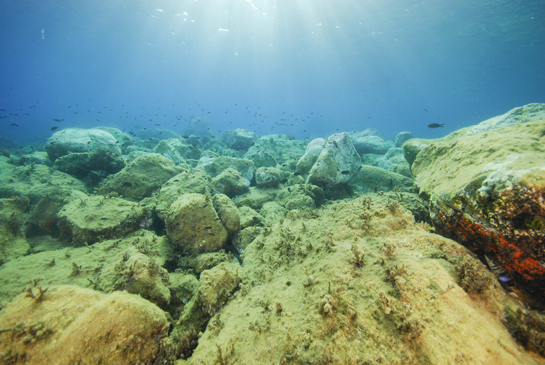 -2m. Un grupo numeroso de castañuelas, Chromis chromis, sobrevuela los bloques de piedra, en donde se observa las consecuencias del ramoneo de los erizos
-2m. Un grupo numeroso de castañuelas, Chromis chromis, sobrevuela los bloques de piedra, en donde se observa las consecuencias del ramoneo de los erizos
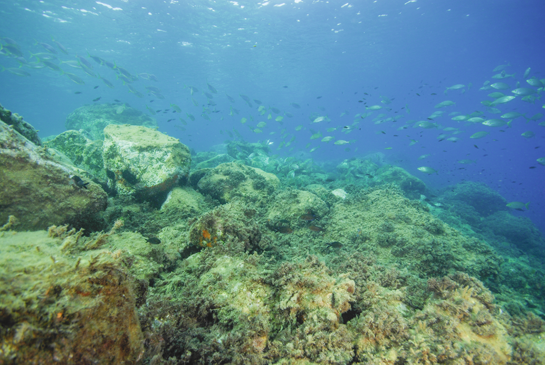 -3m. La Comunidad de Algas Calcáreas y Erizos da paso a una de Algas Fotófilas, en la que busca alimento un banco de salpas Sarpa salpa.
-3m. La Comunidad de Algas Calcáreas y Erizos da paso a una de Algas Fotófilas, en la que busca alimento un banco de salpas Sarpa salpa.
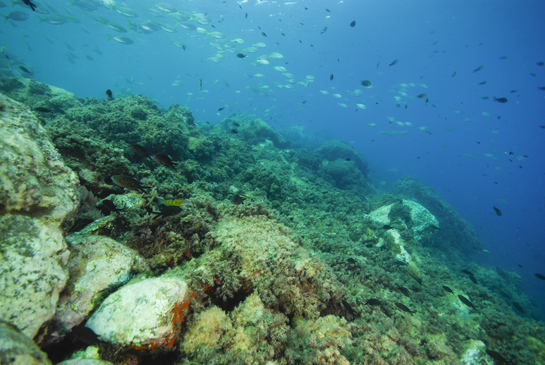 -4m. Las castañuelas Chromis chromis, que se alimentan de plancton, y las salpas Sarpa salpa, herbívoras, nadan sobre esta parte del transecto con mayor pendiente.
-4m. Las castañuelas Chromis chromis, que se alimentan de plancton, y las salpas Sarpa salpa, herbívoras, nadan sobre esta parte del transecto con mayor pendiente.
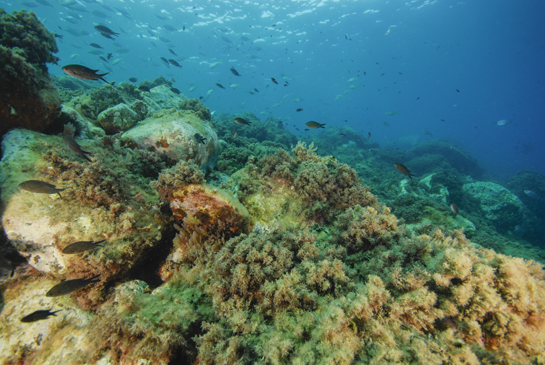 -5m. La poca profundidad de la cara sur del “Dique Roto” posibilita un buen desarrollo de las algas fotófilas.
-5m. La poca profundidad de la cara sur del “Dique Roto” posibilita un buen desarrollo de las algas fotófilas.
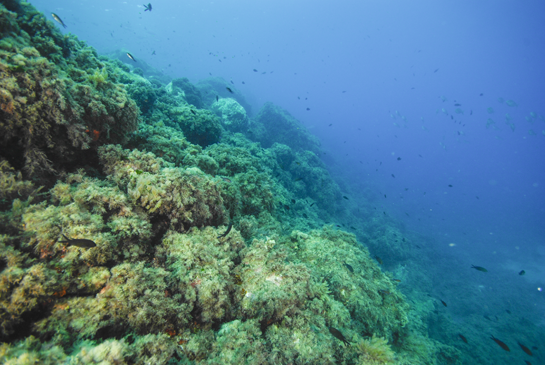 -6m. En esta imagen se puede observar la presencia de algunos ejemplares del alga invasora procedente del Indo-Pacífico Asparagopsis taxiformis.
-6m. En esta imagen se puede observar la presencia de algunos ejemplares del alga invasora procedente del Indo-Pacífico Asparagopsis taxiformis.
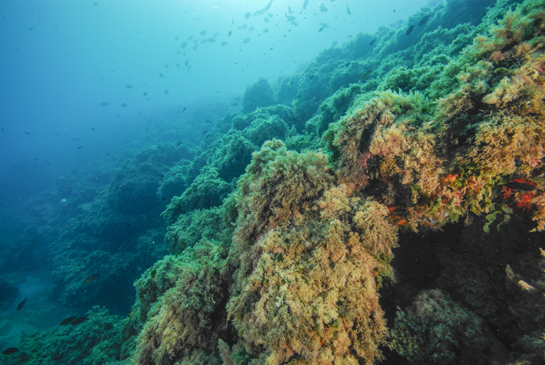 -7m. Un grupo de castañuelas, Chromis chromis, sobrevuela el “bosque” de algas. Este abundante pez, al llegar la noche, busca refugio entre las grietas del fondo y adoptan una coloración más mimética a base de bandas verticales claras y oscuras.
-7m. Un grupo de castañuelas, Chromis chromis, sobrevuela el “bosque” de algas. Este abundante pez, al llegar la noche, busca refugio entre las grietas del fondo y adoptan una coloración más mimética a base de bandas verticales claras y oscuras.
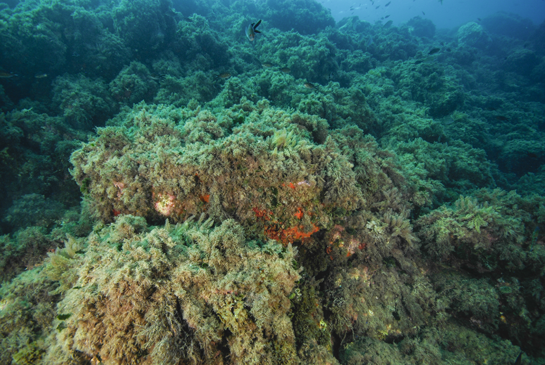 -8m. En algunas zonas del Dique Roto se puede observar como el alga invasora procedente del Indo-Pacífico, Asparagopsis taxiformis, va ganando poco a poco terreno.
-8m. En algunas zonas del Dique Roto se puede observar como el alga invasora procedente del Indo-Pacífico, Asparagopsis taxiformis, va ganando poco a poco terreno.
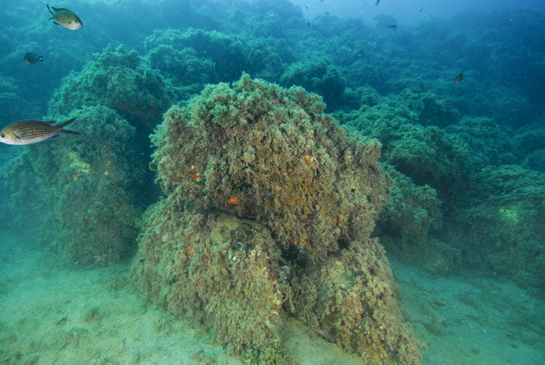 -9m. En las cuevas que forman los bloques de piedra, es posible ver, todavía, algunos meros, aunque muy asustadizos por la presión que la caza submarina ejerce sobre ellos.
-9m. En las cuevas que forman los bloques de piedra, es posible ver, todavía, algunos meros, aunque muy asustadizos por la presión que la caza submarina ejerce sobre ellos.
This page provides information on cookies we use: We use our own and third-party cookies to keep your session active, personalise your experience, and collect anonymous statistics about how you use this website. You can choose to accept all cookies or select which types you'd like to allow. To learn more about the cookies we use, read our Cookies Policy.
We use two types of cookies on this site. First, there are Functional Cookies, which are essential for the website to work properly. They store session data to make your experience smoother and more convenient. On the other hand, Analytical Cookies collect information about how you use the portal, without personal data, helping us provide a better and more tailored service.
Introduction to the Use of Cookies on the MITECO.gob.es Website
Cookies are small files that are stored on your device when you visit a webpage. They are essential tools that help provide many of the services available on the information society. Among other things, cookies allow a webpage to store and retrieve information about a user's browsing habits or their device. Based on this information, they can be used to recognise the user and enhance the service provided.
Types of Cookies
Depending on the entity that manages the domain from which the cookies are sent and processes the data, there are two types of cookies: first-party cookies and third-party cookies.
There is also a second classification based on how long the cookies remain stored in the user's browser: session cookies and persistent cookies.
Finally, cookies can also be classified into five types based on the purpose for which the data is processed: technical cookies, personalisation cookies, analytics cookies, advertising cookies, and behavioural advertising cookies.
For more information on this, you can refer to the Guide on the use of cookies from the Spanish Data Protection Agency.
Cookies used on the website
The web portal of the Ministry for Ecological Transition and the Demographic Challenge uses Adobe Analytics, an analytics tool that helps website and application owners understand how visitors interact with their content. Adobe Analytics uses a small number of cookies to collect data and generate usage statistics for websites. This information is sent anonymously and is not shared with third parties under any circumstances. You can choose to accept or reject these cookies, as they do not affect the portal’s functionality. However, they help provide valuable information that allows us to offer a better and more tailored service. For more information about Adobe Analytics cookies and privacy, please refer to the following links:
Additionally, pages featuring content from social network X will only set cookies if the user is logged into the X site. For more details on these cookies, please refer to the following link: Privacy on Social Network X
Finally, a technical cookie named MITECO-compliance is stored, which is a first-party, technical, and session-based cookie. It manages user consent for the use of cookies on the website, remembering which users have accepted them and which have not, ensuring that those who have accepted are not shown cookie consent messages at the top of the page. This cookie is essential for the proper functioning of the portal.
Cookies Policy Acceptance / Rejection
The Ministry for Ecological Transition and the Demographic Challenge gives you the option to accept or reject cookies that are not essential for the portal's operation. Upon accessing the portal, a message will be displayed in the centre of the page with information about the cookie policy and the following options:
· Firefox
· Chrome
· Safari